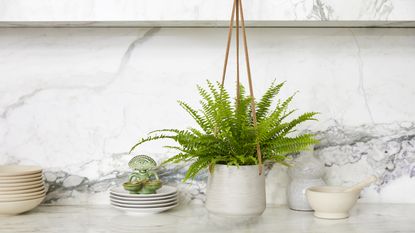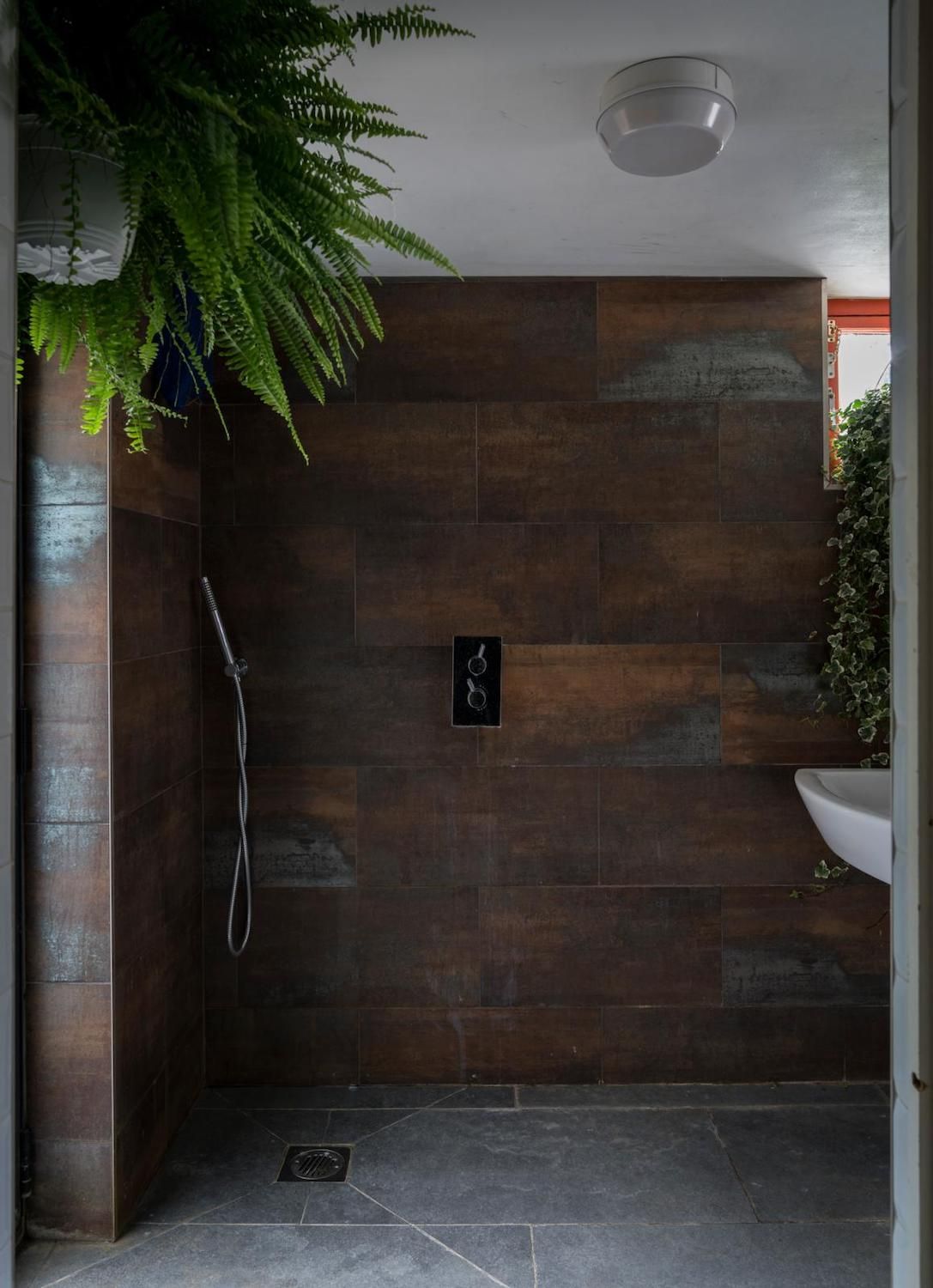Fern care – top tips for fabulous feathery fronds indoors and out
Up your fern care knowledge with tips from plant experts that will ensure your ferns stay lush in your home and garden

Knowing the basics of fern care is essential for keeping these houseplants looking their best. Prized for their lush feathery foliage, ferns are a firm favorite among plant parents, both in the home and garden. So, don't let them disappoint with flaccid fronds.
Ferns are relatively hardy plants, making them a good houseplant for beginners, but they do require some attention, especially around watering. 'Ferns are perfect for rewilding indoor or outdoor spaces,' says Richard Cheshire, plant doctor at Patch Plants. 'However, inside or outside, ferns will need regular watering as they’re fairly thirsty plants.'
'Some ferns are suited to shade only, or a mixture of sun and shade and partial shade, so they are very useful as a textural plant to use in the garden,' says Alex Hollingsworth, garden designer, Dig Club. 'Either combine with other similarly naturally occurring plants or those suited to similar conditions such as Hosta, Hellebore, Bergonia, Asarum europaeum and Liriope.'
The secret to fern care, courtesy of houseplant experts
There's no denying that the addition of some lush greenery brings a space to life. So find out how to keep your ferns looking fabulous indoors and out.
1. Start with an easy variety

There are hundreds of varieties of fern, but the ones you are most likely to see in homes are Boston, Asparagus, Maidenhair and Blue Star.
'Ferns have a reputation for being a little fussy (ahem, Maidenhair) but you can’t go too far wrong with a Boston Fern indoors,' says Jo Lambell, founder of Beards & Daisies. 'They’re pretty robust and have a much greater survival rate than some of its more feathery siblings.'
'A Maidenhair fern attracts many people due to its delicate foliage, but can be hard to keep happy, especially for the more neglectful plant owners,' adds Jemma Charman, co-founder of Green Rooms Market.
'A good variety to start with indoors would be a Blue Star fern or a Boston fern. Like all ferns these will not like to dry between waterings and like high humidity so a bathroom would be best, but they tend to be more forgiving than other varieties.'
'There are many varieties to choose from for the garden,' says Alex Hollingsworth, garden designer and co-founder of Dig Club. 'However, the following ferns will provide different textural qualities, varying levels of year-round interest and are easy to look after; Dryopteris affinis 'Cristata', Polystichum setiferum, Polypodium vulgare and Asplenium scolopendrium.'
2. Place them somewhere humid

It's no coincidence that you often see ferns gracing beautiful bathrooms and shower rooms. These plants thrive in humid places.
'A humid bathroom out of direct sunlight would be ideal,' says Jemma Charman, Green Rooms Market. 'Direct sunlight and not enough humidity will make the ends turn brown and crispy.'
Jo Lambell of Beards & Daisies concurs and adds, 'They also love to be trailed or placed in hanging baskets.'
3. Give them some shade

Not only do these forest floor dwellers love humidity, but they're also used to the shade of larger plants and trees in their natural habitat too, making them the perfect shady garden idea.
'My indoor Boston Fern is happiest in the shadow of a taller palm so he still gets some light but never full sun,' says Morag Hill, co-founder of The Little Botanical.
'Outdoor ferns like to be kept in a shady spot too, as they will scorch in direct summer sun. So find a corner of your garden that needs some green but doesn’t get full sun, they’ll thrive in dappled light.'
'Ferns prefer damp soil and their flexibility makes them perfect for shadier gardens or those creating a woodland or jungle theme,' says garden designer Alex Hollingsworth of the Dig Club. 'Outside, they're usually happy when planted underneath trees.'
4. Keep the soil damp but not soggy

This is where watering can get tricky and where these plants can earn their reputation as divas. However, if you understand the basics of how often you should water your houseplant, it's easy to give your fern what it needs to help it thrive.
'The soil should be kept moist but not soggy with water,' says Jemma Charman. 'It's also best to water ferns from the bottom, sitting their pot in a tray of water for several minutes until the soil looks moist, allowing it to take up what it needs. Remember not to leave it sitting in water for hours on end. It's also best to use rainwater rather than our chemically treated tap water if you can.'
'The key with Boston Ferns is to not let them dry out too much or the leaves can go brown and crispy,' adds Morag Hill. 'Ideally they like to replicate their natural environment of a damp forest floor - so keeping their soil moist is key.
'At the same time, those lovely lush leaves or fronds as they are known, can also go yellow if they’re left to sit in water for too long. If your fern is looking a bit sad, trim off any of the poorly leaves, give it a good drink and some plant food to keep it growing well.'
'Outside ferns generally look after themselves, but it is worth watering them regularly when there are long periods without rain so the soil doesn’t dry out,' says Alex Hollingsworth. 'A mulch on top of the soil (such as composted bark) will help ensure the roots of the fern remain cool and damp.'
5. Mist between weekly waterings

Watering these plants weekly, and checking their soil to make sure it doesn't dry out should keep them happy and healthy. However, if there's not enough humidity for them, you can create it in other ways.
'Ferns will be happiest in a steamy bathroom, so if they’re residing elsewhere indoors, remember to mist them every few days,' says Richard Cheshire, Patch Plants.
6. Prune dead fronds

'Ferns are generally very low maintenance. However you may want to prune any dead or dry fronds off before the new leaf buds (crosiers) start to unfurl in spring,' says Alex Hollingsworth. 'Cut them off at the base with secateurs and clear away debris to encourage air to circulate around the base.'
'When tending to your fern, be careful not to touch it too much – its fronds will go brown if you do,' adds Jo Lambell. 'Think minimal fuss and generally look don’t touch for this gorgeous plant.'
Do ferns need sun or shade?
Ferns need shade to thrive, their natural habitat is the damp forest floor, under the dappled light of taller plants. So it's best if you can replicate this, as much as possible, whether yours are indoors or outdoors.
Do ferns do well in pots?
'Ferns work very well planted in pots and containers as their leaves flop over the edges to create a relaxed and verdant aesthetic,' says garden designer, Alex Hollingsworth.
'They like soil that has organic matter in it and most prefer neutral to alkaline soil. They are best planted in spring or autumn to settle before the cold weather.'
How often should you water a fern?
Water indoor ferns at least once a week, possibly more, depending where you keep it. Check the soil is moist but not soggy and don't let it out dry out between waterings.
Depending where you live outdoor ferns will generally look after themselves, however, they will need watering during a dry spell without rain, to ensure the soil is damp.
Be The First To Know
The Livingetc newsletter is your shortcut to the now and the next in home design. Subscribe today to receive a stunning free 200-page book of the best homes from around the world.
Jacky Parker is a London-based freelance journalist and content creator, specialising in interiors, travel and food. From buying guides and real home case studies to shopping and news pages, she produces a wide range of features for national magazines and SEO content for websites
A long-time contributor to Livingetc, as a member of the team, she regularly reports on the latest trends, speaking to experts and discovering the latest tips. Jacky has also written for other publications such as Homes and Gardens, Ideal Home, Red, Grand Designs, Sunday Times Style and AD, Country Homes and Interiors and ELLE Decoration.
-
 5 Things People With Flattering Bathrooms Never Have — (And You Shouldn't Either!)
5 Things People With Flattering Bathrooms Never Have — (And You Shouldn't Either!)Designers say you should avoid these five things if you want a bathroom that flatters your reflection and therefore uplifts your mood
By Oonagh Turner Published
-
 How to Organize your Bathroom for a Better Morning Routine — 6 Steps for a Seamless Start to the Day
How to Organize your Bathroom for a Better Morning Routine — 6 Steps for a Seamless Start to the DayThe ease of your morning routine can have a huge influence over the rest of the day, so make sure you optimize you space for a stress-free start to the day
By Lilith Hudson Published

